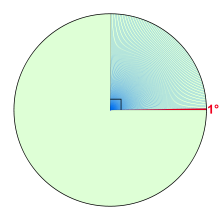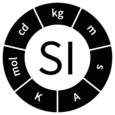Degree (angle)
| Degree | |
|---|---|
 One degree (shown in red) and eighty nine degrees (shown in blue). The lined area is a right angle. | |
| General information | |
| Unit system | Non-SI accepted unit |
| Unit of | Angle |
| Symbol | °[1][2], deg[3] |
| Conversions | |
| 1°[1][2] in ... | ... is equal to ... |
| gons | 10/9g |
A degree (in full, a degree of arc, arc degree, or arcdegree), usually denoted by ° (the
It is not an
History

The original motivation for choosing the degree as a unit of rotations and angles is unknown. One theory states that it is related to the fact that 360 is approximately the number of days in a year. Ancient
Another theory is that the Babylonians subdivided the circle using the angle of an
Another motivation for choosing the number 360 may have been that it is readily divisible: 360 has 24 divisors,[note 1] making it one of only 7 numbers such that no number less than twice as much has more divisors (sequence A072938 in the OEIS).[12] Furthermore, it is divisible by every number from 1 to 10 except 7.[note 2] This property has many useful applications, such as dividing the world into 24 time zones, each of which is nominally 15° of longitude, to correlate with the established 24-hour day convention.
Finally, it may be the case that more than one of these factors has come into play. According to that theory, the number is approximately 365 because of the apparent movement of the sun against the celestial sphere, and that it was rounded to 360 for some of the mathematical reasons cited above.
Subdivisions
For many practical purposes, a degree is a small enough angle that whole degrees provide sufficient precision. When this is not the case, as in astronomy or for geographic coordinates (latitude and longitude), degree measurements may be written using decimal degrees (DD notation); for example, 40.1875°.
Alternatively, the traditional
Maritime charts are marked in degrees and decimal minutes to facilitate measurement; 1 minute of latitude is 1 nautical mile. The example above would be given as 40° 11.25′ (commonly written as 11′25 or 11′.25).[13]
The older system of thirds, fourths, etc., which continues the sexagesimal unit subdivision, was used by
Alternative units

In most
The
] One turn is equal to 360°.With the invention of the
An
| Turns | Radians | Degrees | Gradians |
|---|---|---|---|
| 0 turn | 0 rad | 0° | 0g |
| 1/72 turn | π/36 rad | 5° | 5+5/9g |
| 1/24 turn | π/12 rad | 15° | 16+2/3g |
| 1/16 turn | π/8 rad | 22.5° | 25g |
| 1/12 turn | π/6 rad | 30° | 33+1/3g |
| 1/10 turn | π/5 rad | 36° | 40g |
| 1/8 turn | π/4 rad | 45° | 50g |
| 1/2π turn | 1 rad | approx. 57.3° | approx. 63.7g |
| 1/6 turn | π/3 rad | 60° | 66+2/3g |
| 1/5 turn | 2π/5 rad | 72° | 80g |
| 1/4 turn | π/2 rad | 90° | 100g |
| 1/3 turn | 2π/3 rad | 120° | 133+1/3g |
| 2/5 turn | 4π/5 rad | 144° | 160g |
| 1/2 turn | π rad | 180° | 200g |
| 3/4 turn | 3π/2 rad | 270° | 300g |
| 1 turn | 2π rad | 360° | 400g |
See also
- Compass
- Degree of curvature
- Degrees per second
- Geographic coordinate system
- Gradian
- Meridian arc
- Square degree
- Square minute
- Square second
- Steradian
Notes
- ^ The divisors of 360 are 1, 2, 3, 4, 5, 6, 8, 9, 10, 12, 15, 18, 20, 24, 30, 36, 40, 45, 60, 72, 90, 120, 180, and 360.
- ^ Contrast this with the relatively unwieldy 2520, which is the least common multiple for every number from 1 to 10.
- ^ These new and decimal "degrees" must not be confused with decimal degrees.
References
- ^ HP 48G Series – User's Guide (UG) (8 ed.). Hewlett-Packard. December 1994 [1993]. HP 00048-90126, (00048-90104). Retrieved 6 September 2015.
- ^ HP 50g graphing calculator user's guide (UG) (1 ed.). Hewlett-Packard. 1 April 2006. HP F2229AA-90006. Retrieved 10 October 2015.
- Hewlett-Packard Development Company, L.P. October 2014. HP 788996-001. Archived from the original(PDF) on 3 September 2014. Retrieved 13 October 2015.
- ^ a b Weisstein, Eric W. "Degree". mathworld.wolfram.com. Retrieved 31 August 2020.
- ISBN 978-92-822-2272-0, c. 4, pp. 145–146.
- ISBN 978-0-6151-7984-1. [1]
- .
- ^ Murnaghan, Francis Dominic (1946). Analytic Geometry. p. 2.
- ^ Rawlins, Dennis. "On Aristarchus". DIO - the International Journal of Scientific History.
- Toomer, Gerald James. Hipparchus and Babylonian astronomy.
- )
- ^ Brefeld, Werner. "Teilbarkeit hochzusammengesetzter Zahlen" [Divisibility highly composite numbers] (in German).
- ISBN 9781-9051-04949.
- ^ Al-Biruni (1879) [1000]. The Chronology of Ancient Nations. Translated by Sachau, C. Edward. pp. 147–149.
- ISBN 1-34920177-4.
External links
- "Degrees as an angle measure"., with interactive animation
- Gray, Meghan; Merrifield, Michael; Moriarty, Philip (2009). "° Degree of Angle". Sixty Symbols. Brady Haran for the University of Nottingham.

